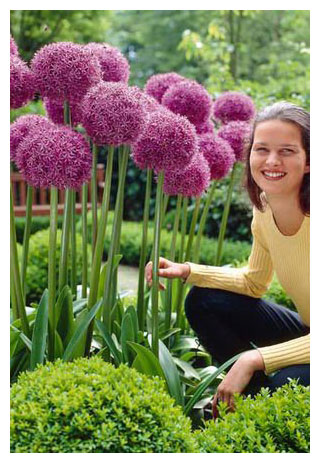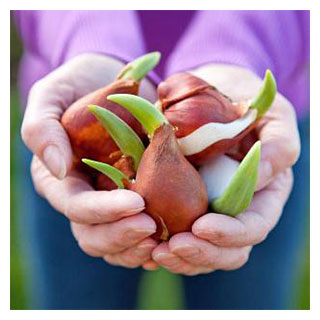Victory Garden 2.0 – Fall is for Planting Bulbs

#FallisforPlanting BULBS – This post is provided as an educational/inspirational service of the National Garden Bureau and our members. Thank you to National Garden Bureau for this article.
I hope you enjoy this article from The National Garden Bureau. Please, when looking for your Fall Bulbs, look first at your local independent garden center. They get #1 quality bulbs directly from Holland. ~S. Fleming
Fall-Planted Bulbs Guarantee a Colorful Spring Garden
Fall is in the air and that means it’s time for mums, pumpkins, apples… and planting spring-blooming flower bulbs! Invest an hour or two this fall to enjoy weeks of color next spring. Flowering fall bulbs have an important energy reserve. Inside each bulb is a reserve of stored energy that helps power the development of roots, shoots, leaves, and flowers. Being so self-sufficient means that flower bulbs don’t have to wait for perfect weather or ideal soil conditions. By nature, they already have what they need to thrive.
Find out why fall bulbs are so easy and rewarding to grow!
Bulbs Are Easy
Flower bulbs are perfectly packaged for easy planting. Just dig a hole and drop in the bulb. Most bulbs aren’t very particular about where they are planted. They will perform as well in pots and containers, as they do in flower gardens, beneath trees and shrubs, and in woodlands, meadows, and even lawns. Planting flower bulbs doesn’t require any special knowledge or experience. Simply plant the bulbs this fall and sit back. When spring arrives, your bulbs will start blooming before anything else in your garden.

Soggy soil can cause flower bulbs to rot, and tulips are especially sensitive to excess moisture. Consider planting tulips in your vegetable garden! The flowers will be finished blooming before it’s time to plant tomatoes, just be careful to not stab the bulbs when planting your veggies!
Bulbs are Bountiful
Nothing says spring like a field of yellow daffodils or a flower bed filled with colorful tulips. Fall-planted bulbs have an astonishing amount of flower power for their size. They’re also inexpensive and it’s surprisingly easy to create a big impact with just a handful of bulbs.
Some types, such as daffodils and scilla, are reliably perennial. Once established, they will bloom for generations and can multiply to carpet large areas with their cheery blooms. Others, including tulips and hyacinths, are usually treated as annuals, which lets you experiment with new color combinations every year.

Different types of daffodils bloom at different times during the spring. The same is true for tulips and alliums. When purchasing bulbs, check the bloom times so you can enjoy a long season of flowers.
Bulbs are Dependable
Each type of flower bulb blooms at a particular time of year and has its own proper planting time. Spring-blooming bulbs such as tulips, daffodils, and alliums, must be planted in the fall for flowers the next spring. Choose a planting location with well-drained soil that gets at least half-day sun.
Planting can begin as early as September and can continue right through early December. For best results, get your bulbs into the ground at least 3 weeks before the soil begins to freeze. Once planted, the bulbs will quickly develop roots and then go to sleep until spring.

In most areas, the best time to plant spring-blooming bulbs is mid-October through mid-November. Don’t worry if you are running late. Just be sure to get them into the ground by early December.
Bulbs Offer Lots of Choices
Spring-blooming bulbs are loved the world over for their brilliant colors and ability to tolerate chilly spring weather. The earliest bulbs, such as snowdrops and crocus, start flowering just as the snow melts. Others follow in quick succession, delivering wave after wave of color, while most other plants are still waking up.
When selecting bulbs, be sure to include early, mid, and late-season bloomers. This way you will always have new flowers coming into bloom. Spring-flowering bulbs that are planted in fall include:
Winter Hardy in Growing Zones 4-7
|
|
|
Note: In areas with relatively warm winters (growing zones 8-10), most of these bulbs will not bloom properly unless they are pre-chilled at 40-45°F for a minimum of 10-14 weeks. Begin chilling the bulbs as soon as you receive them in the fall. Once chilled, they can be planted into the garden or outdoor containers.
Flowering fall bulbs aim to please, and they make it incredibly easy for gardeners to be successful. Simply choose the colors, styles, and combinations you like, tuck the bulbs into the soil, and look forward to months of beautiful spring color.





This Post Has 0 Comments